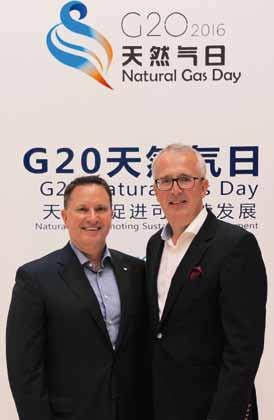Power generation in GPRS of compressor stations By Behnam Mirzaei,
In natural gas transmission systems, compressor
reduction of the gas temperature. A water bath
Abdolrahim Najmi,
stations increase natural gas flowing in pipe
heater is used for heating the natural gas and
Amir Asghari,
lines. Wherever there is an end user for natural
regulating the temperature. It consists of
Mohammad Reza
gas its pressure should be reduced to satisfy
furnace body, burner, smoke fire pipe, heating
Goodarzi.
their needs. The traditional method for reduc
coiler, chimney, control system and fuel supply
ing natural gas pressure is to utilise expansion.
system, including an inlet stop valve and
But there is another newer and more modern
regulator. Also, it can be designed with a filter
method; to utilise turboexpanders. Through
and heater to meet different site conditions.
this method natural gas is not only expanded
The basic working principle is that water is
and its pressure regulated, but also mechanical
heated by fuel gas inside the furnace and then
power can be produced on the turboexpander’s
the hot water exchanges its heat with the
output shaft which can be converted to elec
natural gas via a heating coiler.
tricity via a generator. This paper focuses on
In natural gas transmission systems, there
natural gas pressure reduction stations (GPRS)
are compressor stations which their duty is to
of compressor stations. The results show the
increase natural gas flowing in pipelines. This
amount of the fuel saving using turboexpanders.
increase firstly compensates natural gas pressure loss and secondly provides the natural
Technical background
gas required mass flow at any specific point in
Pressure regulators are widely used in both
the network. Wherever there is an end user for
commercial and residential applications to
natural gas, its pressure should be reduced to
control the operational pressure of gas. Their
satisfy their needs. This demand can be house
task is to reduce a supply pressure to a lower
hold, industry, power plant or a compressor
outlet pressure and this reduction is their key
station itself needing fuel gas for turbo
characteristic. A pressure regulator is a valve
compressors.
that automatically cuts off the flow of a liquid
The traditional method for reducing natural
or gas at a certain pressure. They are used to
gas pressure is to utilise expansion or Joule-
allow high-pressure fluid supply lines or tanks
Thomson valves or regulators as described
to be reduced to safe and/or usable pressures
above. But there is another newer and more
for various applications.
modern method; to utilise turboexpanders.
When choosing a pressure regulator many
This way natural gas is not only expanded and
factors must be considered. Important consider
its pressure regulated, but mechanical power
ations include: operating pressure ranges for the
can be produced on the turboexpander output
inlet and outlet, flow requirements, the fluid,
shaft which can be converted to electricity via
expected operating temperature range, material
a generator.
selection for the regulator components includ ing seals, as well as size and weight constraints. This reduction of the inlet pressure to a lower outlet pressure leads to a significant
78 P o w e r g e n e r a t i o n i n G P R S o f c o m p r e s s o r s t a t i o n s
This article focuses on natural gas pressure reduction stations in compressor stations. Regular compressor stations utilise turbo compressors driven by gas turbines. Each gas


























